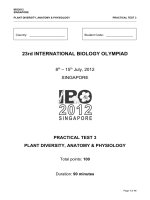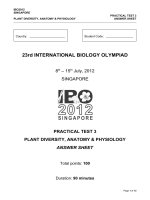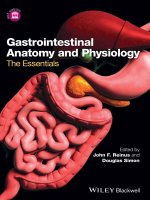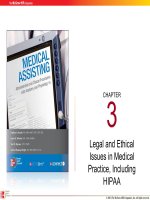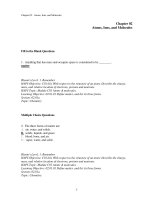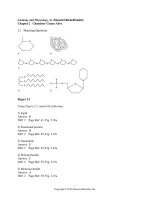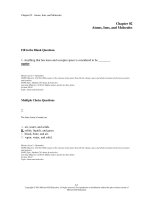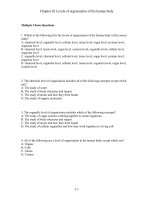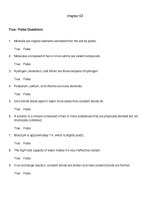Practical test 3 plant diversity anatomy and physiology
Bạn đang xem bản rút gọn của tài liệu. Xem và tải ngay bản đầy đủ của tài liệu tại đây (625.08 KB, 14 trang )
IBO2012
SINGAPORE
PLANT DIVERSITY, ANATOMY & PHYSIOLOGY PRACTICAL TEST 3
23rd INTERNATIONAL BIOLOGY OLYMPIAD
8
th
– 15
th
July, 2012
SINGAPORE
PRACTICAL TEST 3
PLANT DIVERSITY, ANATOMY & PHYSIOLOGY
Total points: 100
Duration: 90 minutes
Page 1 of 14
Country: _____________________ Student Code: ________________
IBO2012
SINGAPORE
PLANT DIVERSITY, ANATOMY & PHYSIOLOGY PRACTICAL TEST 3
Dear Participants
• In this test, you have been given the following two tasks:
Task I: Plant diversity and anatomy. (60 points)
Part A: Morphology of seedlings (10 points)
Part B: Seed morphology and anatomy (27 points)
Part C: Ficus propagule dissection (5 points)
Part D: Functional, ecological and phylogenetic aspects of seeds and seedlings (18
points)
Task II: Plant anatomy and physiology. (40 points)
Part A: Anatomy of a plant stem (13 points)
Part B: Study of leaf epidermis and physiology (17 points)
Part C: Interpretation of photosynthetic data (10 points)
• Use the Answer Sheet, which is provided separately, to answer all the questions.
• The answers written in the Question Paper will NOT be evaluated.
• Write your answers legibly in ink.
• Please make sure that you have received all the materials and equipment listed for each task. If
any of these items are missing, please raise your hand immediately.
• Stop answering and put down your pen IMMEDIATELY when the bell rings.
• At the end of the test, place the Answer Sheets and Question paper in the envelope provided.
Our Assistants will collect the envelope from you.
Have fun and Good Luck!
Page 2 of 14
IBO2012
SINGAPORE
PLANT DIVERSITY, ANATOMY & PHYSIOLOGY PRACTICAL TEST 3
Materials and equipment:
For Task I: Plant diversity and anatomy
Materials and equipment Quantity Unit
Seedlings: A, B, C and D (in plastic cups) 1 specimen
Seeds/propagules: 1 to 7 (in labelled plastic bags) 1 specimen
Specimen E (in labelled plastic bag) 1 specimen
razor blade 1 piece
scissors 1 pair
hand lens 1 piece
For Task II: Plant anatomy and physiology
Materials and equipment Quantity Unit
Leaves, L (in petri dish L) 2 piece
Stems, S (in petri dish S) 2 piece
concentrated HCl (in bottle labelled H, placed within a beaker) 1 bottle
Phloroglucin stain (in bottle labelled P) 1 bottle
water (in wash bottle) 1 bottle
filter paper 2 sheet
forceps 1 pair
razor blade 2 piece
plastic dropper 1 piece
petri dish (with water, labelled W) 1 piece
petri dish (labelled LL, LU and SS with the correct student code) 3 piece
beaker (small) 1 piece
glass slides 3 piece
cover slips 3 piece
compound microscope 1 set
Page 3 of 14
IBO2012
SINGAPORE
PLANT DIVERSITY, ANATOMY & PHYSIOLOGY PRACTICAL TEST 3
Task I (60 points)
Plant diversity and anatomy
Part A. Morphology of seedlings (14 points)
Q1.1 (0.5 points × 20 = 10 points; 2 points for quality of drawing; 2 points for not damaging
specimens) Make a simple schematic diagram of each seedling (A – D) in the
corresponding space provided in the Answer Sheet and label the following (if present) with
a to e and indicate if any are absent:
a. cotyledons
b. epicotyl
c. hypocotyl
d. leaves
e. seed coat
Part B. Seed morphology and anatomy (27 points)
Each seedling (A to D) from Part A comes from seeds 1-4 respectively.
Q1.2 (0.25 points × 12 = 3 points) Draw each whole seed (1 – 6) in the corresponding space
provided in the Answer Sheet (Note: (1) you do not need to draw Seed 7; (2) seed coat of
Seed 5 has been removed). Label the following (if present) with a and b and indicate if any
part is absent:
a. seed coat
b. site of attachment of funiculus
Page 4 of 14
IBO2012
SINGAPORE
PLANT DIVERSITY, ANATOMY & PHYSIOLOGY PRACTICAL TEST 3
Q1.3 (0.5 points × 24 = 12 points; 1 point for quality of drawing) After drawing the exterior of
each seed, dissect in longitudinal section and draw the sectioned seed in the corresponding
space provided in the Answer Sheet. (Note: Some seeds have been pre-cut for your
convenience. The seed coat of Seed 5 has been removed.). Label/indicate the following
items on your diagram with a to d:
a. cotyledons
b. food storage
c. hypocotyl
d. seed coat
Q1.4 (0.5 points × 24 = 12 points) Indicate the likely ploidy (1N, 2N or 3N) of each of the items
labelled “a” to “d” in Q1.3 in the Answer Sheet.
Part C.Ficus propagule (5 points)
Q1.5 (1 + 1 + 3 points) Dissect Specimen E longitudinally and draw the longitudinal section of the
propagule. Draw and label an enlarged section to show in detail the features of a to c.
a. fruit
b. seed
c. stigma
Part D.Functional, ecological and phylogenetic aspects of seeds and seedlings (18 points)
Q1.6 (0.5 points × 12 = 6 points) Based on the observations in Parts A, B and C, and the
information given in the Table provided in the Answer Sheet, indicate the primary function
of the cotyledon with P (for photosynthesis) or S (for storage of nutrients) and the probable
germination pattern with O (orthodox: seed can undergo dormancy) or R (recalcitrant: seed
does not undergo dormancy).
Page 5 of 14
IBO2012
SINGAPORE
PLANT DIVERSITY, ANATOMY & PHYSIOLOGY PRACTICAL TEST 3
Q1.7 (1 point × 5 = 5 points) Based on the information in the Table and the diagrams that you
have drawn, determine if each of the following statements is true () or false ().
a. All tropical plants have recalcitrant seeds.
b. Gymnosperms have at most two cotyledons.
c. Cotyledon function is phylogenetically constrained within plant families.
d. Seed size varies considerably in plant families and is probably not phylogenetically
constrained.
e. Large seed size may be advantageous for some tropical rainforest plants.
Q1.8 (1 point × 4 = 4 points) The phylogenies of Malvaceae and Moraceae, and a simplified
phylogeny of seed plants are provided on the next page. Using this information, as well as
the specimens that you have observed today, determine if each of the following statements
is true () or false (), or if there is insufficient evidence to conclude (–) in the Answer
Sheet.
a. Large seeds have evolved independently in multiple lineages.
b. Large seeds have evolved on more than one occasion in some lineages.
c. Recalcitrant seeds are more associated with tropical plants than with temperate plants.
d. Gymnosperms are unable to produce fleshy structures associated with animal dispersal
because they lack ovaries.
Page 6 of 14
IBO2012
SINGAPORE
PLANT DIVERSITY, ANATOMY & PHYSIOLOGY PRACTICAL TEST 3
Phylogeny of Malvaceae Phylogeny of Moraceae
Simplified phylogeny of seed plants
Page 7 of 14
Gymnosperms
(Seeds 5, 6, 7)
Monocots
Asteraceae + related families
Moraceae
+ related families
(Seed 2, Specimen E)
Malvaceae, Sapindaceae
+ related families
(Seeds 1, 3, 4)
IBO2012
SINGAPORE
PLANT DIVERSITY, ANATOMY & PHYSIOLOGY PRACTICAL TEST 3
Task II (40 points)
Plant anatomy and physiology
Part A. Anatomy of a plant stem (13 points)
Procedure:
1. Using the razor blade, cut thin transverse sections of the stem, S.
2. Float the cross-sections in water in petri dish, W.
3. Place a drop of water onto a glass slide and transfer the best cross-section to the centre of the
slide.
4. Place a small drop of phloroglucin stain (P) onto the cross-section, followed by a small drop of
concentrated hydrochloric acid, HCl (H). Be very careful when handling H as it is corrosive.
5. Leave for 1 minute and then remove excess stain with the filter paper.
6. Cover the cross-section with a coverslip and examine it using the compound microscope under
low magnification (4× objective lens).
Answer the following questions in the Answer Sheet:
Q2.1 (1 point) Is S a monocot stem or dicot stem? Indicate M for monocot and D for dicot.
Q2.2 (1 point) Is there any pith? Indicate presence of pith with a tick () and absence with a
cross ().
Q2.3 (1 point) Where is the vascular bundle in the stem located? Indicate centre with C and
periphery with P.
Page 8 of 14
IBO2012
SINGAPORE
PLANT DIVERSITY, ANATOMY & PHYSIOLOGY PRACTICAL TEST 3
Q2.4 (0.5 points × 3 = 1.5 points) Based on your observations, is S the stem of a shrub,
tree, or herb? Indicate correct answer(s) with a tick () and incorrect answer(s) with a
cross () in the Answer Sheet.
Q2.5 (0.5 points) Identify the tissue (a – e) that is stained red. Indicate the correct answer
with a tick () in the Answer Sheet.
a. cortex
b. endodermis
c. epidermis
d. phloem
e. xylem
7. When you have completed Part A, place your slide with the stem section into the petri dish SS
for grading purposes.
Q2.6 (8 points)
Part B. Study of leaf epidermis and physiology (17 points)
(i) Lower epidermis
Procedure:
1. Peel off the lower epidermis of the leaf, L, with a pair of forceps.
2. Place it in a drop of water on a glass slide and cover the peeled layer with a cover slip.
3. Examine it using the compound microscope under 10× objective lens.
Page 9 of 14
IBO2012
SINGAPORE
PLANT DIVERSITY, ANATOMY & PHYSIOLOGY PRACTICAL TEST 3
Answer the following questions in the Answer Sheet:
Q2.7 (2 points) Do you see any stomata? Indicate presence of stomata with a tick ()
and absence with a cross ().
Q2.8 (3 points) Measure the lengths and widths of FIVE (5) epidermal cells that are
representative of the majority of the cells. Smallest unit in the eyepiece micrometer
as seen under 10× objective lens is 10 µm. Calculate the mean values and fill in your
answer in the table provided.
4. When you have completed Part B (i), place your slide with the epidermal peel into the
petri dish LL for checking purposes. The slide will also be used to check for accuracy of
your measurement of epidermal cell dimensions.
(ii) Upper epidermis
Procedure:
1. Peel off the upper epidermis of the leaf, L, with a pair of forceps. You may either use
the same leaf as before or a fresh leaf from petri dish L.
2. Place it in a drop of water on a glass slide and cover the peeled layer with a cover slip.
3. Examine it using the compound microscope under 10× objective lens.
Page 10 of 14
IBO2012
SINGAPORE
PLANT DIVERSITY, ANATOMY & PHYSIOLOGY PRACTICAL TEST 3
Answer the following questions in the Answer Sheet:
Q2.9 (2 points) Do you see any stomata? Indicate presence of stomata with a tick ()
and absence with a cross ().
Q2.10 (3 points) Measure the lengths and widths of FIVE (5) epidermal cells that are
representative of the majority of the cells. Smallest unit in the eyepiece micrometer
as seen under 10× objective lens is 10 µm. Calculate the mean values and fill in your
answers in the table provided.
4. When you have completed Part B (ii), place your slide with the epidermal peel into
the petri dish LU for checking purposes. The slide will also be used to check for
accuracy of your measurement of epidermal cell dimensions.
Q2.11 (0.5 point × 3 = 1.5 points) Based on your observations in Part B (i) and (ii),
indicate the correct answer(s) with a tick () and incorrect answer(s) with a cross ().
a. There are more stomata in the lower epidermis than in the upper epidermis.
b. Epidermal cells of the upper epidermis are smaller than those of the lower
epidermis.
c. Stomata are separated from each other by at least one cell.
Q2.12 (1 point) Based on your observations, determine what type of plant this is. Indicate
the correct answer with a tick () in the Answer Sheet.
a. hydrophyte
b. mesophyte
c.xerophyte
Page 11 of 14
IBO2012
SINGAPORE
PLANT DIVERSITY, ANATOMY & PHYSIOLOGY PRACTICAL TEST 3
Q2.13 (0.5 point × 5 = 2.5 points) Some statements about stomatal structure, function and
development are given below. Indicate true statement(s) with a tick () and false
statement(s) with a cross ().
a. Stomata consist of a pair of highly specialized guard cells that are usually
surrounded by a pair of larger subsidiary cells.
b. Guard cells differ significantly from other epidermal cells in that they have
chloroplasts.
c. Chloroplasts of guard cells differ from mesophyll chloroplasts in that they lack
grana.
d. The number of stomata on any leaf surface is under genetic control and is not
modified by any environmental factors.
e. Stomatal development involves asymmetric cell divisions.
Part C. Interpretation of photosynthetic data from plants measured at different CO
2
concentrations
(10 points)
Introduction
Single leaves were harvested from plants A and B that had been grown under full sunlight in the
same greenhouse. The responses of their net photosynthetic CO
2
assimilation rates to varying
levels of ambient CO
2
under saturating light intensity of 1,200 µmol quanta m
–2
s
–1
at 25 ºC and 21%
O
2
measured on detached leaves in the laboratory are given on the next page:
Page 12 of 14
IBO2012
SINGAPORE
PLANT DIVERSITY, ANATOMY & PHYSIOLOGY PRACTICAL TEST 3
Ambient CO
2
concentration (µl l
-1
)
Net photosynthetic CO
2
assimilation rate
(µmol CO
2
m
–2
s
–1
)
Plant A Plant B
20 0.5 -4
40 11 -1
60 19 2.5
80 28 5.5
100 33 9
180 41 18
300 44 27
400 44 32
600 44 40
800 44 44
1000 44 45.5
Q2.14 (4 points). Plot a graph by using the data above for Plant A and B in Graph 1 provided in
the Answer Sheet. Use an X-axis scale from 0 to 1000 µl l
-1
.
Based on Graph 1, answer the following questions in the Answer Sheet:
Q2.15 (1 point) Indicate whether plants A and B are C
3
or C
4
plants. Indicate the correct answers
with a tick () in the Answer Sheet.
Q2.16 (2 points) What is the net photosynthetic CO
2
assimilation rate for Plant A and Plant B
measured at 200 µl l
-1
of CO
2
concentration?
Page 13 of 14
IBO2012
SINGAPORE
PLANT DIVERSITY, ANATOMY & PHYSIOLOGY PRACTICAL TEST 3
Q2.17 (2 points) Plot another graph by using CO
2
assimilation rate from 20 to 100 µl l
-1
of CO
2
concentration only (i.e., at low CO
2
concentrations) for Plant B in Graph 2 provided in the
Answer Sheet. Use an X-axis scale from 0 to 100 µl l
-1
.
Q2.18 (1 point) Based on Graph 2, what is the CO
2
compensation point for plant B? Write the
value in the Answer Sheet.
Q2.19 (1 point) Compared to the data in Graph 2, would the CO
2
compensation point increase,
decrease or remain unchanged if the measurements were carried out at 35 ºC and 21% O
2
?
Indicate the correct answer(s) with a tick ( ) in the Answer Sheet.
Q2.20 (1 point). Compared to the data in Graph 2, would the CO
2
compensation point increase,
decrease or remain unchanged if the measurements were carried out at 25 ºC and 2% O
2
?
Indicate the correct answer(s) with a tick ( ) in the Answer Sheet.
END OF PAPER
Page 14 of 14
